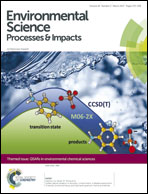The degradation mechanism of sulfamethoxazole under ozonation: a DFT study†
Abstract
Sulfamethoxazole (SMX), a kind of antibiotic, remains in the environment and threatens public health. Ozone as a strong and green oxidant was widely used for selective oxidation degradation of residual SMX. However, it is hard to elucidate the detailed oxidation mechanism through current experimental approaches. A theoretical study has been carried out herein for exploring possible ozonation pathways of SMX. Two reaction mechanisms, viz., direct addition (DA) and H atom transfer (HAT), are considered. The results show that the primary oxidation of aromatic rings (benzene or isoxazole rings) of SMX follows the DA mechanism, featuring an electrophilic addition. Whereas, the oxidation of amino and methyl groups of SMX follows the HAT mechanism. Following the proposed mechanisms, the primary oxidation products detected in previous experiments could reasonably be obtained according to the current calculations. More importantly, O3 molecules as an electrophilic agent feasibly attack the moiety having a large orbital contribution to the highest occupied molecular orbital (HOMO) of sulfonamides. This result suggests that the primary ozonation site of sulfonamides could be theoretically predictable through the information of their frontier molecular orbitals. Meanwhile, a positive correlation between the O3-mediated HAT energy barriers and bond dissociation energies has been found for N–H and C–H bond oxidations.

- This article is part of the themed collection: QSARs and computational chemistry methods in environmental chemical sciences


 Please wait while we load your content...
Please wait while we load your content...